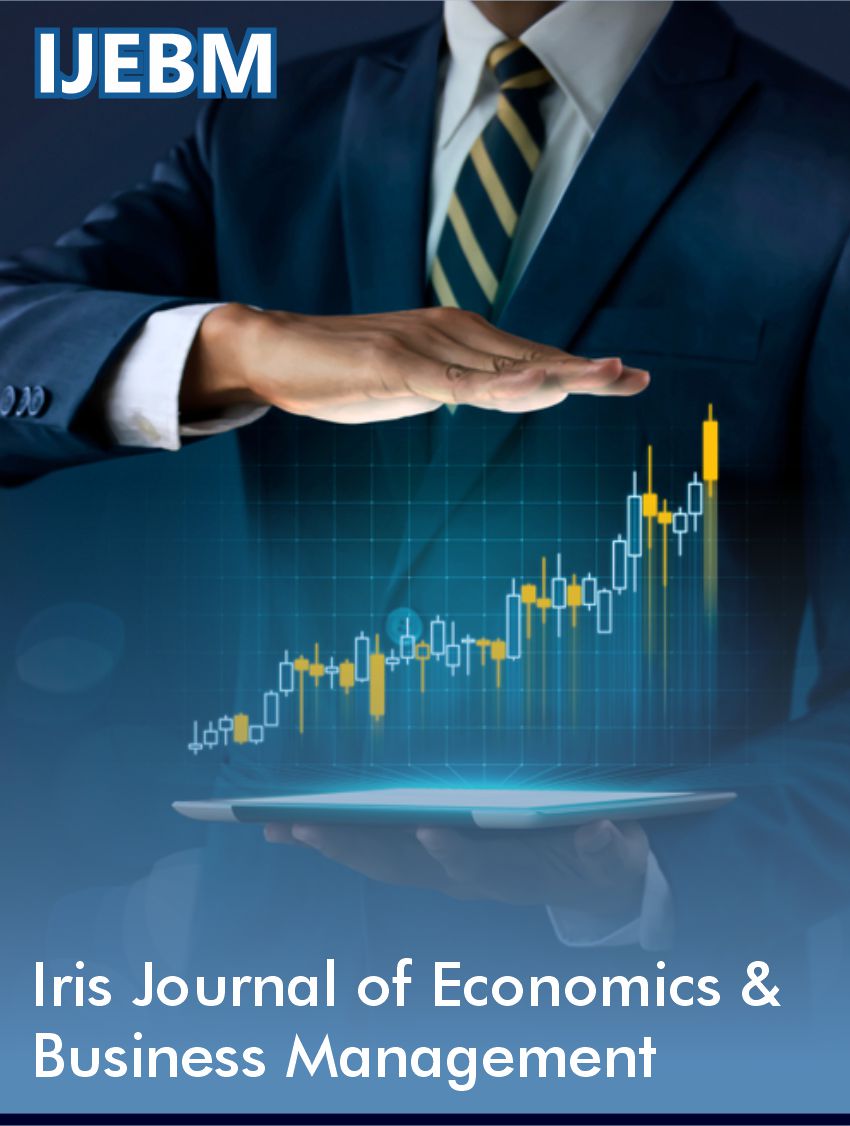 Research Article
Research Article
International Migration of Researchers: Impact of Professional Drivers
Olena Oliinyk*
The National University of Water and Environmental Engineering, Ukraine
Olena Oliinyk, The National University of Water and Environmental Engineering, Rivne, Ukraine.
Received Date: May 03, 2023; Published Date: May 12, 2023
Abstract
The purpose of the study is to determine the professional drivers which have the greatest influence on the international mobility of research scientists and to assess the level of attractiveness of EU Member States for researchers from other countries on the noted basis. The research paper used the case study of the European Union countries and derived the latest data on first employment permits issued to migrants, intellectual migrants and researchers from the Eurostat database, as well as sub-indices of the Global Innovation Index regarding research and development (R&D), knowledge creation, absorption, impact and diffusion. The author combined the methods of structural and dynamic analysis, correlation analysis and taxonomic analysis in the research process. The results obtained from the structural and dynamic analysis revealed that in recent years, on average every fourth migrant has come to EU countries aiming to find a job. In 2021, Poland topped the list among all EU Member States: every sixth permit was issued to migrants in this country. There is an overwhelming amount of evidence that the EU is one of the most attractive destinations for intellectual migration flows. In 2021, 85.04% of all first residence permits issued for employment-related reasons in the Netherlands were issued to highly skilled migrant. The value of this indicator for Austria was 70.32%, for Ireland it was 58.15%, and for Denmark it was 55.68%. The outcomes of the correlation analysis proved that countries with a high level of economic development prefer to issue the first-residence employment permits mainly to intellectual migrants. At the same time, competent issuing authorities in Germany, Slovakia and Hungary give priority to researchers when issuing the first permits. In order to investigate the importance of the professional drivers of researchers’ migration, the author identified seven subpillars of the Global Innovation Index, which directly relate to research and development, creation and migration of knowledge. The results of the correlation analysis allowed the scholars to choose four drivers of researchers’ migration, which have the greatest impact on the dependent variable (i.e. Y, which is a share of first permits issued to researchers in the total number of first-residence permits issued for employment-related reasons, %). The study defined such drivers as “Research and development (R&D)” sub-pillar, “Knowledge workers” sub-pillar, “Innovation linkages” subpillar, and “Knowledge creation” sub-pillar. Basing on these sub-pillars, together with the application of the taxonomic analysis, the paper assessed the attractiveness of EU countries for researchers from other countries. Hence, the author conducted an analysis of the differentiation of the EU Member States according to the values of the taxonomic indicator and proved a high level of EU countries’ attractiveness for researchers from other countries, as the distribution of the comprehensive indicator is within 0.77-1.0. The practical significance of the suggested method of comprehensive assessment of the EU countries’ attractiveness for foreign researchers lies in the possibility of its application by the public and private sectors to monitor the migration of scientists and researchers aiming to improve the migration policy, develop R&D and innovation activities.
Introduction
In today’s world, where research is conducted on a truly global basis, collaboration and mobility play a central role in research and development. International mobility shapes the world in which we live, it ensures the circulation of knowledge, skills and ideas around the world, whereas in the global research system intellectual migration involves scientists following the best science, the greatest resources and the most advanced technologies. Thus, migration in scientific professions largely occurs from the periphery to the centre of the world system of science [1]. Attracting and supporting researchers and scientists who are able to generate knowledge and implement innovations is the key to success in improving productivity and ensuring global competitiveness. Thus, innovationoriented countries compete intensively to attract the best scientists and researchers. They allocate significant resources to create a favourable economic and professional environment for intellectual migrants. In this aspect, it is worth mentioning the Korean Initiative for fostering Universities of Research and Innovation (KIURI), which is focused on promoting the independence of postdoctoral researchers. Spain has created a programme allowing the recipient of a postdoctoral fellowship to choose the host institution. The Japan is allowing young researchers employed on a research project to pursue their own research choices for up to 20% of their time. Belgium plans to increase the success rate of postdoctoral fellowships to 30%. Meanwhile, Portugal has created collaborative laboratories with the private sector, and provided fiscal incentives to employ doctorate holders (OECD, 2021). Reforms discouraging inventor mobility reduce the patenting of MNEs within a country, while reforms favouring the arrival of researchers from other countries have a positive effect on this process [2].
Taking into account that, in the EU countries, researchers create scientific developments and implement them in business practice particularly actively, this leads to the gradual growth of the share of R&D personnel and researchers in total active population and employment. If in 2012 the share of R&D personnel and researchers (percentage of total employment - numerator in fulltime equivalent) was 1.28%, then in 2021 it increased to 1.62% (EC, 2022d). Wide application of the results of scientific work in business enterprise sector, government sector, higher education sector, private non-profit sector leads to an increase in demand for scientists and researchers from other countries. The Eurostat statistical data confirm this hypothesis, namely:in 2020 compared to 2013 the total number of foreign researchers from European non- EU countries increased by 226% in Poland, by 408% in Bulgaria, and by 56% in Slovenia (EC, 2022c).
Today, in the process of global transformations, the international mobility of scientists and researchers is increasingly associated with such topics as economic competitiveness, the spread of technical know-how, workforce training, or the need to improve the international reputation of universities and other research institutions. Simultaneously, the justification of researchers’ mobility drivers is focused on the predominance of professional and individual objectives, such as personal fulfilment and career development. Nowadays, if a professor, researcher or scientist leaves his/her native country, s/he is looking for a proper job, career growth, a decent salary and a high quality of life [3].
Hence, the overall objective of the research paper was to determine the professional factors which have the greatest influence on the international mobility of research scientists and to assess the level of attractiveness of EU Member States for researchers from other countries on the noted basis. The study used the case study of the European Union countries and derived the latest data on first employment permits issued to migrants, intellectual migrants and researchers from the Eurostat database (EU, 2022a-e), as well as sub-indices of the Global Innovation Index regarding research and development (R&D), creation, absorption, impact and knowledge diffusion [4]. The authors combined the methods of structural and dynamic analysis, correlation analysis and taxonomic analysis in the research process. The paper consists of four major sections: the literature review substantiates the modern perspectives of investigating both push and pull factors of intellectual migration; section 2 is based on the noted review and deals with the selection of professional drivers of the international migration of researchers and the justification of the methodological principles of assessing interconnections between them; section 3 covers the presentation of the study results, together with the evaluation of the attractiveness of EU countries for foreign researchers using the taxonomic analysis method. Finally, section 4 summarizes the facts that can be used as a basis for developing recommendations for increasing the level of involvement of foreign researchers to introduce innovations, develop the economy and ensure sustainable competitiveness of the country.
Literature review
Globalisation and the shift towards a knowledge economy have made researchers among the most sought-after resources. International research mobility has been encouraged at policy levels and has remarkably increased in the past decade [5]. At the same time, answering the question of what exactly drives international migration is a complicated scientific task. The answer may seem simple and obvious, such as finding better opportunities to live and work in another country, but the scientific community has been trying to reach a consensus on understanding the main drivers of international migration for many years [6-8]. In general, migration drivers are structural elements that have the potential to facilitate, enable, constrain, and trigger migration processes. Migration drivers might increase or decrease the salience of migration, the likelihood of certain migration routes, and the desirability of different destinations [9]. These factors include the characteristics of a country of origin which may affect levels of emigration, bilateral relations between countries which may affect the direction of migration, and the features of destination countries which either attract or discourage immigration to them [10]. However, the international scientific community does not have a defined point of view regarding the differentiation of the main drivers of migration in general, and the migration of researchers in particular. Castelli [11] notes that ‘macro’-, ‘meso’- and ‘micro’-factors influence migration, as a complex phenomenon. The scientist views the political, demographic, socio-economic and environmental situations as ‘macro-factors’ and defines them as major contributors to migration. Among the ‘meso-factors’, communication technology, land grabbing and diasporic links play an important role. ‘Micro-factors’ such as education, religion, marital status and personal attitude to migration also have a key role in making the final decision to migrate an individual choice. Brennan [12] also adheres to the distribution, but assigns different components to each level. So, the researchers believe that macrolevel includes employment opportunities, active recruitment and poor working conditions; meso-level: better training and development opportunities, a desire to experience working in a different environment, opportunities to gain clinical experience through short-term employment and opportunities for research; while micro-level: financial gain for self (and/or family), desire for life change or a better quality of life.
At the same time, Czaika and Reinprecht classify migration factors not by levels, but by spheres of occurrence, distinguishing between nine dimensions of the driving migration force: demographic, economic, environmental, human development, individual, politico institutional, security, socio-cultural, and supranational. Scientists suggest differentiating the factors that facilitate, enable, constrain, and trigger migration processes. According to the results of the study, professional training and professional education to advance one’s career are main driving factors for high-skilled migration, and it is these factors that consistently occupy one of the top positions in the decision-making process to change the place of residence and work of highly qualified workers in favour of foreign countries [9].
The concept of distinguishing pull and push migration drivers has become widespread in the scientific community [13-16]. In one paper [13] it is noted that push factors include conditions that force people to leave their homes and they are classified into economic, social and political factors. The pull factors are the opposite of the push factors. They include various aspects that attract people to a certain place of residence and they are also classified into economic, social and political factors of migration. Naumovski [3], in addition to the three selected groups, also proposes to include factors that are related to the mental desire of the individual (or group of people) for better his/their (family) social status. At the same time, the scholar identifies such major social factors as possible educational solution, better career advancement opportunities, and culturally disseminated knowledge of other areas, which ‘pull’ intellectual migrants.
Naumovski claims that highly qualified and talented professionals are in the field of investigation on adequate opportunities to express their acquired skills and knowledge. For them, working is earnings and simulation for higher levels of management. Therefore, for such migrants, professional factors are fundamental when changing their place of residence and looking for work abroad. Furthermore, it has been proven that the brain that migrated to a selected elsewhere could produce 4.5 times more publications and 10 times more patents than its home counterparts, and the main causes of brain drain are non-financing, technical support and non-infrastructure in home countries [3].
Thus, the literature review allows us to state that in the case of international migration of scientists and researchers, it is the professional drivers of migration that are truly decisive [17-20]. Particularly, the objective of another research (Siekierski et al., 2018) was to investigate which of the following factors is most important in the academics mobility decision: the impact of the science, technology and innovation (ST&I) infrastructure, or the quality of life in the host country The scientists considered journals of scientific prestige and research and development (R&D) institutions as proxies for ST&I and the human development index (HDI) as a proxy for quality of life. The results of a multiple linear regression show that, although the ST&I infrastructure takes precedence over quality of life. That is, the noted category of highly qualified workers tends to change their place of residence precisely in search of the best conditions for employment, research, knowledge create and diffusion. Scientists are attracted to scientific systems which are large (measured by the number of researchers, for instance), wealthy (in terms of R&D expenditure), more productive (in terms of publications and patents) and highly internationalised [1].
The internationalization and specialization of science confront scientists with opportunities during their careers. In this aspect, it is worth recalling the research of Netz with colleagues, which examines the impact of international mobility on the main aspects of the scientists’ careers. The authors identified eight (8) drivers or dimensions of scientist mobility (listed in descending order), which comprise: scientists’ international networks, scientific productivity, occupational situation, scientific impact, competences and personality, scientific knowledge, access to research infrastructures and funds, and symbolic capital. The researchers also claim that existing research provides robust evidence of positive effects of international mobility on the broadening of scientists’ networks [21].
Given its broad impact on individual careers, migration phenomenon essentially enriches the entire scientific knowledge base by enhancing the flow of knowledge across multiple fields. Indeed, it may be immensely useful to uncover the underlying dynamics behind the field migration of scientists, as it affects the ways in which people plan career, agencies fund research, researchers organise and discover knowledge, and governments recognise and reward excellence [22].
Chang and Huang [23] view the migration of researchers as a form of academic training and a positive phenomenon for personal career and scientific research development. The geographical movement of scientists mostly occurs during the early stage of their research career. Since international mobility is inextricably linked to the management of an academic career, it must be considered within the framework of the specific features of the scientific career. Nevertheless, individual career ambitions are not the only factor behind scientists’ desire to migrate. Other aspects of academia and larger societal characteristics also act as pull factors, i.e. forces that determine the country’s attractiveness to foreign researchers. Employment features such as access to better funding schemes and collaboration with research centres of excellence are obvious ones [24].
Thus, the drivers of international migration of researchers include better personal and professional opportunities in the host country, favourable immigration policies for highly educated workers, differences in the scientists’ quality of life, interaction with other professionals [2]. Therefore, countries such as Canada, New Zealand, Germany, the United States and the United Kingdom now have aggressive recruitment policies for highly qualified foreigners to increase their own skilled labour force, particularly in a globalised global economy where intellectual workers are highly coveted [25]. Delicado notes that among the most common factors of ‘attractiveness’ are not only scientific conditions (the resources available for scientific activity, namely funding and equipment; the quality of the research environment; development in cuttingedge areas; the opportunity to work in the team of a prominent scientist) and professional conditions (training and employment opportunities, wages, career progression) but also political (democratic regimes, incentives granted to skilled immigration) and cultural (language, lifestyle, cosmopolitanism, the presence of communities from the country of origin) [1].
While studying the attractiveness of countries for highly qualified migrants, we should mention the results of the study by Urbinati and colleagues [26]. The scientists studied international migrations of researchers, scientists, and academics, to better understand the so-called “brain drain” phenomenon, if and how it can be measured, and how it changes over time. The authors discussed why some trivial measures can be ineffective, and as a consequence, they built the global scientific migration network to identify the most important countries involved in the mobility of scholars, and to study their role at a local and a global scale. It is also attention-grabbing that the performance of centres and authorities can change over time as a result of positive management decisions to attract migrants, suggesting that local and/or global policies can counteract existing trends. Therefore, countries should increase their educational efforts and research capabilities and improve infrastructures and living conditions of scientists and researchers, as these factors are key in shaping the country’s attractiveness for intellectual migrants [19]. Hence, the study of the “pull” factors affecting researchers from other countries is a scientific task that remains relevant constantly. The results of this study, as well as the investigation of the experience of EU countries that attract scientists and researchers are important for improving the migration policy of the countries which experience a loss of intellectual potential.
Methodology
Given the purpose of the study, the author formulated the following research questions:
RQ1. What are the recent patterns of researcher migration to the EU?
In order to explore this issue, the author calculated the share of foreign researchers in the total number of migrants and, particularly, labour migrants across 27 EU Member States basing on first employment permits issued to migrants. The structural analysis of the indicators was supplemented with the dynamic analysis, which enabled identifying existing trends in this area and determining the relevance of this issue for different EU countries (EC, 2022a; EC, 2022b).
RQ2. Is there a relationship between the share of intellectual migrants in the total number of labour migrants and the level of economic development of the country? That is, do countries with a high level of economic development prefer to issue the firstresidence employment permits mainly to intellectual migrants?
Aiming to explore this issue, the author calculated the Pearson product-moment correlation coefficient [27,28] between GDP per capita, PPP$ [4] and the share of first permits issued to intellectual migrants in the total number of first-residence permits issued for employment-related reasons (calculated by the author according to (EC, 2022b)). Within the framework of the study, the author has chosen GDP per capita as an indicator for assessing the level of economic development of the country, taking into account that currently it is the main global indicator for measuring the average prosperity and well-being of a country and the vast majority of scientists and practitioners use it to analyse the well-being of a country based on its economic growth. The calculations are based on the 2021 data for 27 EU Member States.
The study used the formula for the t-test [29] in order to check the statistical significance of the correlation coefficient.

where r are the values of the correlation coefficient; and n is the total number of observations.
RQ3. What are the main professional drivers stimulating the international migration of researchers?
The analysis within the Literature Review section confirmed that the best conditions for employment, research, knowledge creation and diffusion are the imperative drivers of international migration for researchers. Therefore, in order to investigate the importance of the professional drivers of researchers’ migration, the author selected the indicators listed in (Table 1). Aiming to explore RQ3, the author considered the data on the innovative development of EU countries in 2021 used for the calculation of the Global Innovation Index [4]. As a result, the researcher identified seven sub-pillars of the Global Innovation Index, which directly relate to research and development, creation and migration of knowledge. The author checked the relationship between the dependent variable (Y) and the professional drivers of international migration of researchers (independent variables Х1 – Х7) using the Pearson product-moment correlation coefficient according to the formula [28].
Table 1: Indicators for Assessing the Importance of Professional Drivers of the International Migration of Researchers.
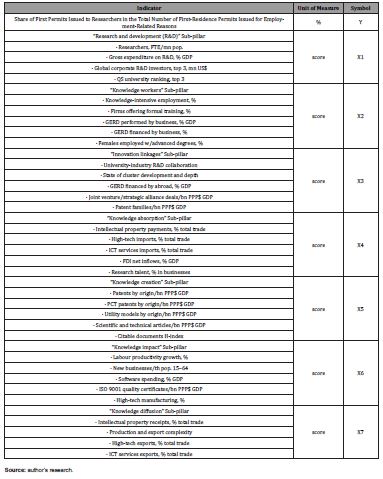
In order to justify the most significant drivers of international migration of researchers, the study applied the interpretation of the calculated correlation coefficients according to the generally accepted guidelines [30-32]. The results of the correlation analysis allowed the scholars to choose four drivers of researchers’ migration, which have the greatest impact on the dependent variable (i.e. Y, which is a share of first permits for researchers in the total number of first-residence permits issued for employmentrelated reasons, %), i.e. for which the calculated correlation coefficient exceeds 0.6. The study defined such drivers as “Research and development (R&D)” sub-pillar, “Knowledge workers” subpillar, “Innovation linkages” sub-pillar, and “Knowledge creation” sub-pillar. Basing on these sub-pillars, together with the application of the taxonomic analysis, the paper assessed the attractiveness of EU countries for researchers from other countries. Aiming to conduct a comprehensive assessment of the attractiveness of EU Member States, the author used a taxonomic indicator of the system development level based on the research of Pluta, W. [33]. This indicator has been selected basing on the following advantages:
1. it is a synthetic value, “equivalent” of all features that characterise the research objects, hence it enables linear arrangement of the elements of the studied aggregate.
2. the indicator is normalised and ranges between 0 and 1, therefore it allows ranking the studied objects by the level of development.
3. the value of the indicator is easy to interpret: values close to 1 correspond to a high level of development of the analysed objects, and values close to 0 correspond to a low development level.
Conducting a taxonomic analysis facilitates ordering a multidimensional system toward a vector norm. Applying taxonomy helps to “contract” the multidimensional statistical data that characterises a system in time and space and convert it into a single quantitative characteristic. Hence, it will ensure the calculation of the comprehensive assessment of the attractiveness of EU Member States for foreign researchers and increase the effectiveness of migration management.
Result and discussion
It is worth starting the study of the international migration of researchers and the exploration of the RQ1 by determining their number in the total number of all migrants, including labour migrants. According to official Eurostat data, the number of firstresidence permits issued to migrants during the last decade demonstrates a steady increase (EC, 2022a). If in 2013 their total number for the EU (28 Member States) was 2,357,846 permits, in 2018 it increased to 3,240,718 permits. The structural analysis of the EU Member States identified the leading country, which was Great Britain. In 2018, almost 14% of all first-residence permits to migrants were issued by this European country. Overall, in the UK the proportion of researchers and doctoral candidates who are from outside the UK has been steadily increasing over the past decade. The United Kingdom is an important internationally recognised training ground, attracting a large number of international doctoral candidates and, while being a part of the EU, the country has led the EU in hosting European Research Council and Marie Skłodowska- Curie Action researchers [34]. Brexit has changed this trend and between 2019 and 2021 the number of first-residence permits issued to migrants decreased by 2.17% (EC, 2022a). At the same time, employment remains the main reason for migration to EU countries, increasing its share in the total population from year to year (Table 2).
Table 2: Total Number of First Residence Permits in General and Those Issued for Employment-Related Reasons During 2019-2021 in EU Member States.

Therefore, in recent years, on average every fourth migrant has come to EU countries aiming to realise his/her professional ambitions. In 2021, Poland topped the list of first residence permits granted in the EU to non-EU citizens among all EU Member States: every sixth permit was issued to migrants in this country. It is worth underlining the constant growth of Poland’s share during the studied period; hence Poland has been the principal destination for migrants in the recent years. It was followed by Spain (6.61% of total permits issued in the EU) and Italy (3.79%). Austria, Malta, Luxembourg, Latvia, Cyprus, Greece, Ireland, Estonia, Bulgaria, Belgium and Denmark accounted for less than one percent of the total number of first residence permits issued for employmentrelated reasons.
The structural analysis across EU countries revealed significant regional heterogeneity. So, in 2021, in the total number of all first residence permits, the highest shares for employment-related reasons were recorded in Croatia (98.51%), Lithuania (75.98%) and Slovakia (75.18%). Hungary, Romania, the Czech Republic and Slovenia are also among the EU Member States where the first residence permits issued for employment-related reasons were predominant compared to other reasons for migration (family reasons, education reasons and other reasons). The fewest number of migrants who came for employment-related reasons, was recorded in Austria (8.22%), Greece (9.57%) and Belgium (9.84%). First residence permits issued for remunerated activities include such major reasons as EU Blue card, highly skilled workers, researchers, seasonal workers and other employment reasons. Intellectual migration covers EU Blue card, highly skilled workers and researchers. The basis of the justification of this thesis is the definition of the essence of these concepts, namely:
a. researchers are professionals engaged in the conception or creation of new knowledge, products, processes, methods and systems, and in the management of the projects concerned (EC, 2022e).
b. highly qualified employment means the employment of a person who: in the Member State concerned, is protected as an employee under national employment law and/or in accordance with national practice, irrespective of the legal relationship, for the purpose of exercising genuine and effective work for, or under the direction of, someone else, is paid, and, has the required adequate and specific competence, as proven by higher professional qualifications (EU, 2009).
c. EU Blue Card means the authorisation bearing the term ‘EU Blue Card’ entitling its holder to reside and work in the territory of a Member State under the terms of Council Directive 2009/50/EC (EU, 2009).
Thus, the number of first residence permits issued to intellectual migrants by the 27 EU Member States has been increasing since 2013 (Figure 1). The decrease recorded in 2020 was caused by Brexit.
Today, the EU is one of the most attractive destinations for intellectual migration flows. Its considerable wealth, as well as its social and welfare approach, is a target for many highly skilled migrants and asylum seekers from many countries [35]. Simultaneously, there are national differences between countries, particularly economically advanced countries are more likely to be net recipient of tertiary graduates, while less developed countries tend to lose their highly educated workers (Zhang & Lucey, 2019). The relative indicators calculated in Table 3 confirm this thesis as they are characterised by significant regional differentiation across EU countries.
The data shows that in 2021, 85.04% of all first residence permits issued for employment-related reasons in the Netherlands were issued to highly skilled migrant. The value of this indicator for Austria was 70.32%, for Ireland it was 58.15%, and for Denmark it was 55.68%. It can be argued that countries with a high level of economic development have the highest value of this indicator. In order to confirm this hypothesis and explore the RQ2, the author calculated the correlation coefficient between GDP per capita, PPP$ and the share of first permits issued to intellectual migrants in the total number of first-residence permits issued for employmentrelated reasons, %. Its value is 0.596. The obtained correlation coefficients are statistically significant, which is confirmed by the Student’s t-test calculated according to the formula [1] (see Methodology section). The estimated value calculated according to the formula [1] is 3.73, which is greater than the critical (Table) value (2.06) at p<0.05.

The statistical significance of the calculated correlation coefficient allows the author to assert a direct and moderate relationship between the studied indicators, that is, countries with a high level of economic development prefer to issue the first employment permits mainly to intellectual migrants. The obtained result confirms the data from other studies, which prove the positive impact of the migration of highly qualified workers on the country’s competitiveness and its economic growth [36,37]. Consequently, it has been proven that the governments of the EU Member States are interested in the increase of the number of intellectual migrants who possess the appropriate educational level, modern knowledge and progressive competences. These are the conditions for the country to realise its innovative potential and achieve sustainable competitiveness under the circumstances of globalisation, as well as constant internal and external challenges.
Table 3: First Residence Permits Issued to Researchers Compared to the Total Number of First Residence Permits Issued for Employment-Related Reasons and the Number of Intellectual Migrants in 2021 in EU Member States.
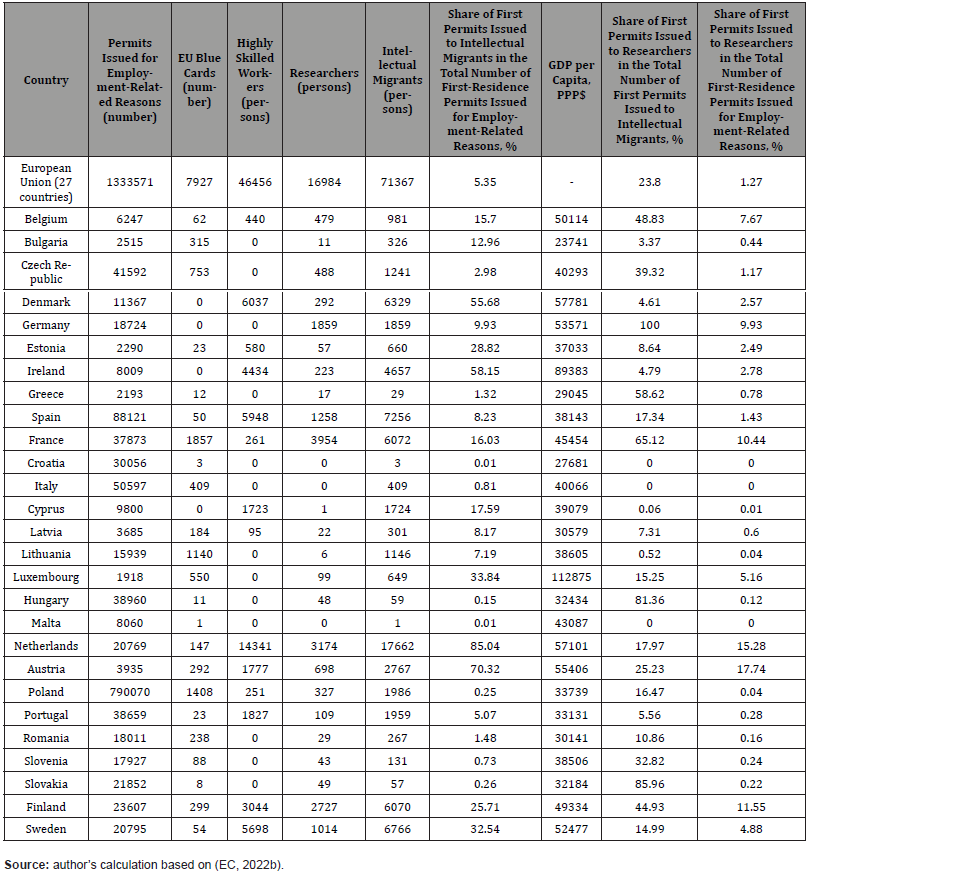
The defined purpose of the study necessitated the calculation of the share of the first employment permits issued to researchers compared to the number of first residence permits issued for employment-related reasons to intellectual migrants and the total number of first residence permits issued for employment-related reasons (Table 3). The structural analysis across EU countries revealed the leaders. Hence, for Germany, when issuing the first residence permits issued for employment-related reasons to intellectual migrants, researchers are a priority, as in 2021 all of them were issued to this cohort. Eight out of ten intellectual migrants in Slovakia and Hungary are researchers. For France and Greece, this indicator exceeds 50%. At the same time, in 2021, Malta, Croatia and Italy are outsiders in terms of the number of first residence permits issued to researchers among all EU Member States. There are various reasons for this situation. For example, Malta is an innovative country with a twenty-first century approach to digitisation and economic development, e.g. as concerns blockchain technology. Access to research results lies at the very core of the innovation economy. However, Malta is not yet up to speed when it comes to practising Open Science, which creates a discrepancy between two interrelated areas: research and innovation (EC, 2020). An important component in creating and accelerating sustainable and innovative economies is a strong academic open data community and an active involvement of research in the development and implementation of the national open data agenda. While open data research in Croatia is advancing and promising, it is not sufficiently mature to support or to steer the open data agenda and to realize the full economic and societal potential of open data [38]. Italy, for instance, typically has issues with the remuneration of scientists. Almost half of researchers (and three PhD candidates out of four) in Italy say that they are paid badly or just enough to make ends meet. Associate professors in Italy are not satisfied by their remuneration in 42 per cent of cases. Among post docs and junior researchers 60 per cent of those in Italy report bad pay or pay just to make ends meet [39].
While considering the share of first residence permits issued to researchers in the total number of all issued first employment permits, one can see that this indicator is also heterogeneous across EU countries. At the same time, the correlation with the level of economic development of the country is moderate, since the value of the calculated coefficient is 0.404. In 2021 Austria had the largest share of first residence permits issued to researchers compared to all first residence permits issued for employment-related reasons (17.74%). A fairly high level of involvement of researchers from among all labour migrants in the Netherlands (15.28%), France (10.44%), and Finland (11.55%).
Nevertheless, there are also EU member states that in fact did not issue the first residence permits to researchers in 2021, that is, their shares were less than 1%. They include 14 of the 27 EU countries. This trend could have been caused by two main factors. On the one hand, the country may not be attractive for researchers from other countries, and therefore they do not want to realise their intellectual potential in this country. For example, one study [40] has a comprehensive assessment of the attractiveness of EU countries for intellectual migrants. This assessment helped identifying a group of countries (Luxembourg, Ireland, Sweden, Finland, Denmark, and the Netherlands) with the highest level of migration attractiveness in the EU. None of the mentioned countries belongs to those where the share of researchers in the total number of labour migrants is small.
Another reason may be the orientation of the migration policy to attract skilled workers with a low- and medium-level of qualification. If immigration policy aims to promote migration of low-wage essential occupations in the medium-to-long term, especially if workers are expected to be able to move between sectors, then governments will consider the long-term economic impact of these workers when designing immigration policies, promoting their broad participation in the domestic labour market [41].
As part of exploring RQ3, the author conducted a correlation analysis of the relationship between the factors listed in (Table 1). The outcomes of the correlation analysis confirmed the high importance of conditions for employment, research, knowledge creation and diffusion in the EU Member States for attracting researchers from foreign countries, since the values of four out of seven correlation coefficients exceed 0.6 (Table 4). On the other hand, “Knowledge absorption” sub-pillar and “Knowledge diffusion” sub-pillar (0.4852 and 0.4454, respectively) currently have a weak influence. Student’s t-distribution was applied to assess the statistical significance of the correlation coefficients Formula 1. Six out of seven correlation coefficients are statistically significant, as the calculated values of the Student’s criterion exceed the critical value. The exception is the “Knowledge impact” sub-pillar (Х6), where for the correlation coefficient statistical significance has not been confirmed (Student’s criterion < critical value). It is worth bearing in mind that this indicator currently does not actually affect the migration of researchers. Therefore, the increase in labour productivity (on average over three years), the density of new firms entering the market, expenditures on software, the number of certificates of compliance with ISO 9001 issued to companies, as well as indicators of high- and medium-tech manufacturing in the total manufacturing do not belong to the modern determinants of intellectual migration on the territory of the EU Member States.
Table 4: Outcomes of the Correlation Analysis Between the International Migration of Researchers and the Professional Drivers of Their Migration.
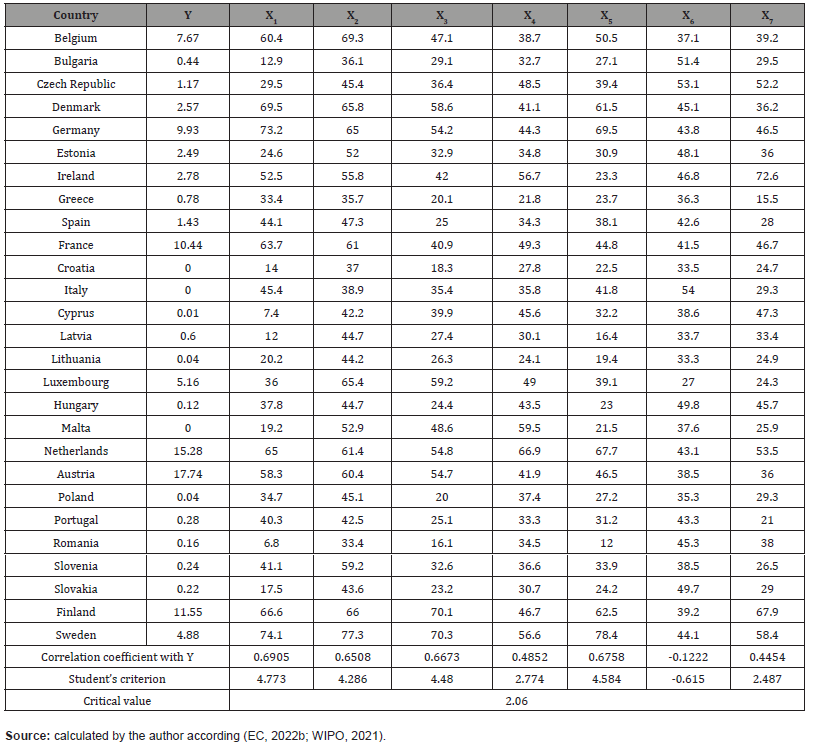
As one can see from the calculations, “Research and development (R&D)” sub-pillar in the Global Innovation Index has the most significant influence on researcher migration (correlation coefficient value 0.6905). This result confirms the decisiveness of the high level and quality of scientific research activity in the country to attract foreign researchers. In order to evaluate these factors, the assessment takes into account such indicators as the number of researchers in full-time equivalent (FTE) of R&D personnel, research and development costs, and the quality of scientific and research institutions (measured by the average score of the top three universities in the QS World University Ranking). Overall, investment in science and innovation has shown remarkable resilience amid the massive economic toll of the COVID-19 pandemic, which has caused the worst economic downturn in decades (WIPO, 2021). Therefore, the more efforts and investments are devoted to R&D and highly educated individuals, the more predictable the innovation is [42].
The next driver of the migration of researchers by the level of importance is the “Knowledge creation” sub-pillar (Х5), which concerns the formation of favourable conditions for the effective work of researchers in the field of knowledge creation (correlation coefficient value is 0.6758). It includes five indicators that are the result of inventive and rationalising activities. Hence, researchers prefer to migrate to those countries where they can more likely realize their intellectual capital, resulting in patent applications, utility model applications, published scientific and technical articles in peer-reviewed journals, an economy’s number of articles (H) that have received at least H citations. This result is in line with other studies in this area. Particularly, the econometric estimations highlight a positive correlation between educated migrants and the number of patent applications [42], while Prato substantiates that migrants increase patent applications by 42% per year on average [43].
The third professional driver of researchers’ migration according to the ranking of importance is innovative connections and public/private/academic partnership (“Innovation linkages” sub-pillar – correlation coefficient value is 0.6673). Cooperation between business and university in research works; prevalence of well-developed and deep clusters; a significant share of gross expenditure on research and development funded abroad as a percentage of GDP; number of joint venture agreements and strategic alliances attract highly skilled workers from all over the world. In general, an increase in the number of highly skilled migrants positively affects innovative performance [44], taking into account not only individual scientists and inventors, but also organisations that employ them and shape cooperation and collaboration in the field of research and development [45].
The “Knowledge workers” sub-pillar (correlation coefficient value is 0.6508) which takes into account the employment opportunities of scientists and researchers in organisations and institutions that meet their expectations and professional aspirations closes the list of the most important drivers of researchers’ migration. This vector offers more information about the degree of the development of intellectual capital that is currently in use in EU countries, and also provides an insight into the gender distribution of the workforce. The results of the research [46] indicate that the gender gap in the labour market in donor countries is an important factor in shaping the intentions of female researchers to migrate abroad. A cross-sectional perspective shows the gender-specific disadvantages that highly skilled migrant women face, including unequal gender arrangements [47]. Therefore, the private and public sectors should improve the perception of female talents, integration and employment of researchers by developing specific measures in the field of shaping gender-oriented migration policy.
The results of the correlation analysis allowed the scholars to identify four drivers of researchers’ migration, which have the greatest impact on the dependent variable (i.e. Y, which is a share of first permits for researchers in the total number of first-residence permits issued for employment-related reasons), i.e. for which the calculated correlation coefficient exceeds 0.6), respectively to a generally recognised scale [30-32]. The study defined such drivers as “Research and development (R&D)” sub-pillar (Х1), “Knowledge workers” sub-pillar (Х2), “Innovation linkages” sub-pillar (Х3), and “Knowledge creation” sub-pillar (Х5). Taking into account the significant influence of these indicators on the migration of researchers, the attractiveness of a particular EU Member State in 2021 was assessed using the taxonomic analysis method. Unlike other research methods, the calculation of the taxonomic index ensures comprehensive evaluation of multidimensional objects vs. the normative reference vector. In this manner, there is a possibility to conduct a holistic assessment of the attractiveness of EU Member States for researchers from other countries using one comprehensive indicator, which is designed by means of a system with various partial indicators.
The evaluation process based on the calculation of taxonomic indicators includes the following major stages:
1. standardisation of the baseline data in order to summarise them within a single measurement scale, which is carried out according to the following formula:
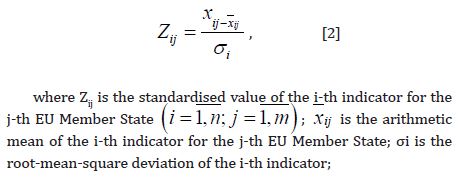
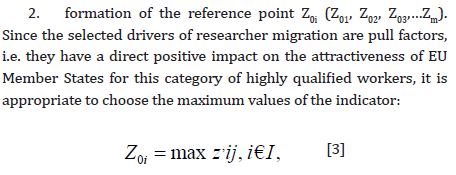
where І is a set of pull factors.
Table 5 shows standardised values for indicators (factors) and the relevant values of reference points.
Table 5: Standardized Values of Baseline Data for a Comprehensive Assessment of the Attractiveness of EU Member States for Foreign Researchers in 2021.
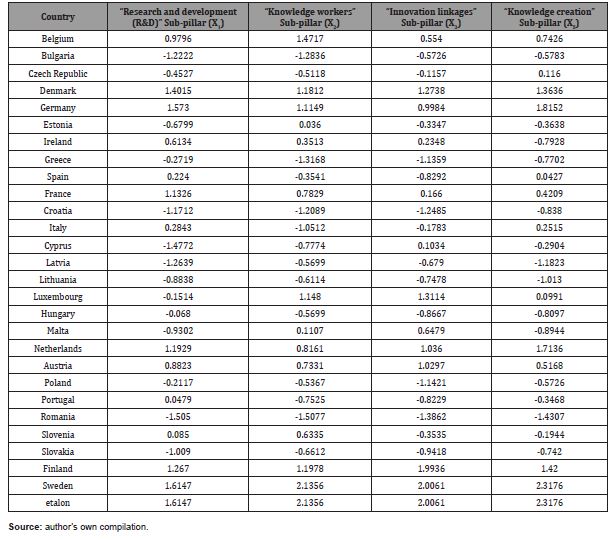
3. construction of the Euclidean distance, which characterises the distance from the value of each indicator to the reference point:

where d0i d is the Euclidean distance from the indicator value to the reference point.
4. calculation of a taxonomic index reflecting a comprehensive assessment of the level of attractiveness of EU Member States for researchers from foreign countries (Ki):
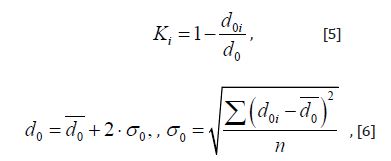
where Ki is a comprehensive assessment of the level of attractiveness of an individual EU Member State for researchers from foreign countries; 0 d is the arithmetic mean of the corresponding Euclidean distance; 0 σ is the root-mean-square deviation of the corresponding Euclidean distance. The index calculated according to this method is the integral indicator, with values ranging from 0 to 1: the closer the resulting value is to 1.0, the higher the level of attractiveness of the corresponding EU Member State is for foreign researchers.
The obtained results of the taxonomic analysis demonstrate a high level of attractiveness of the EU Member States for foreign researchers, since all values of the integral index exceed 0.8. The only exception is Romania, for which the taxonomic index is 0.7799. That is, researchers from other countries are least interested in working and engaging in scientific research in this country. Moreover, Romania not only does not attract scientists, but also demonstrates the features of such phenomenon as the brain drain process in recent years [48,49].
The taxonomic index values calculated in Table 6 made it possible to get the top three in terms of the level of attractiveness of EU Member States for researchers from foreign countries. The highest indicators were recorded in Sweden with the maximum possible value of 1.0, and, hence, it topped the list. If previously migration to Sweden mainly included low-skilled migrants who found jobs in industry, since the 2010s, the country has mainly welcomed highly skilled migrants belonging to highly paid occupations [50]. In addition to the significant financial costs paid by the private and public sectors for research and development, Sweden is also famous for its quite effective educational collaboration activities between various subjects. At the same time, such cooperation is mutually beneficial, as researchers receive orders and funding of scientific research, and companies benefit from the transfer of knowledge, development of innovative products and processes, development and testing of prototypes [51].
Table 6: Calculation of the Integral Attractiveness Index of EU Member States for Researchers from Foreign Countries.
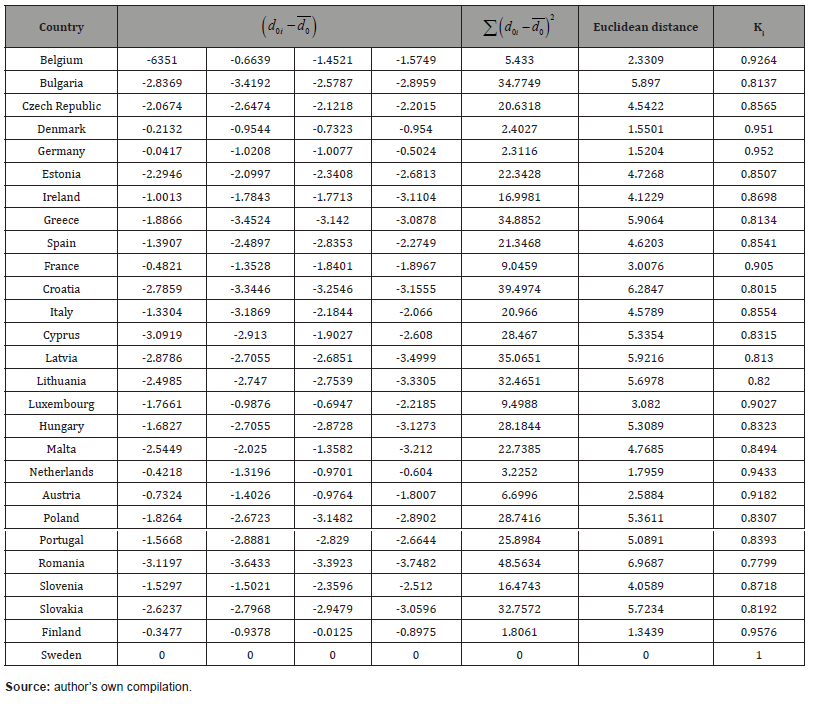
Finland (0.9576) ranks second in terms of the attractiveness among EU Member States. In case of this country, the issue of creation and dissemination of knowledge is extremely important, and the innovations formed on its basis have a statistically significant positive impact on the dissemination of knowledge from other countries and form a demand for highly qualified workers [52]. Therefore, three key insights regarding the positive Finnish national policy experience in fostering public and private investments in research and development are the following: a systemic and integrated policy approach regarding an impactful co-ordination and governance mechanism; a balanced innovation system with well-working joint public-private partnership efforts and mechanisms; investing in long-term capabilities [53].
Germany was the third among three top-ranked countries with a taxonomic index value of 0.9520. This European country is particularly attractive to foreign researchers for its highly R&D intensive industries within manufacturing and knowledgeintensive services [54]. Denmark (0.9510) is almost at the same level as Germany with an effective network of R&D and design organisations. Knowledge, intellectual property, intellectual assets, intellectual capital and ultimately innovative entrepreneurship play a key role in ensuring the economic growth of this country [55].
The analysis of the calculated taxonomic indices made it possible to single out a group of 17 countries for which the values range from 0.8 to 0.89 [56-58]. So these are the EU Member States that have a high level of attractiveness for foreign researchers, however significant intra-European competition requires the introduction of new measures to create favourable conditions for life and work of such professionals. In other words, there are certain issues in migration policy, organisational, legal, and financial aspects of R&D activities, etc., the solution of which will lead to attracting more foreign researchers with better knowledge, skills, and abilities [59- 65].
Conclusion
In modern times, the migration of scientists and researchers has a significant impact on well-being of countries: it is both moulded by and helps to mould their economic, social and cultural transformations. The relevance of this issue is constantly increasing among other areas of scientific research. Global challenges and upheavals, for instance the war in Ukraine, which resulted in a significant increase in migration flows, facilitate this trend. The drivers of researcher migration identified in this study and the integral attractiveness index of EU Member States calculated on their basis pose the foundation for creating optimal ways to increase the countries’ attractiveness for such specialists from abroad. At the same time, professional factors remain to be in focus, that is, the most important measures should be related to improving the working conditions of researchers in the host country. The professional factors that are essential for each country, include creating conditions to unveil the potential of researchers’ professional development and opportunities for their career growth.
The results of theoretical and applied research contribute to economic progress due to the development of the latest equipment, technologies, mechanisms and products, as well as increase of productivity in quantitative and qualitative dimensions. On the other hand, scientific knowledge production, marketing and dissemination via academic and commercial institutions has also become one of the elements of economic investment. This stimulates the growth of competition between EU Member States with regard to the attraction and retention of foreign scientists and researchers. Given the results of the analysis of the differentiation of the EU Member States according to the values of the taxonomic indicator one can state that the level of EU countries’ attractiveness for researchers from other countries is high. This conclusion was made in accordance with the obtained distribution of the comprehensive indicator, which ranges from 0.77 to 1.0. The generally high level of indicators, which comprehensively assess the conditions of R&D activities in the EU countries, explains the obtained values. Simultaneously, the application of the suggested methodology for assessing the countries’ attractiveness for foreign researchers allows identifying ‘bottlenecks’ for each partial driver and creating favourable economic, professional and social conditions for the use of the identified reserves.
The findings obtained within this study can be used by politicians and representatives of the public administration sector to monitor the migration of scientists and researchers, as well as its existing and potential impact on regional, national and global economies. The results of this study are of critical practical importance for managers. Business sector can also widely use the comprehensive approach to assessing the attractiveness of EU Member States based on taxonomic analysis, especially given the growing demand for highly qualified labour. The issue of attracting highly educated specialists with the appropriate level of qualification is complicated by the fact that rapid changes in the local and global labour markets are in many ways ahead of the development of the statistical base for their monitoring. Therefore, it is surely a benefit of the suggested evaluation method as it allows the stakeholders to do this, because it also takes into account micro-level indicators, such as firms offering formal training, GERD performed by business, GERD financed by business etc.
The research and relevant analysis findings suggest that at the current stage of the knowledge economy formation in the EU, the most important factors for the attraction of foreign researchers are the growth of R&D expenditures from both public and private sectors, as well as the formation of favourable conditions for knowledge creation, which will lead to the increase in the number of patent applications, the number of scientific publications and utility models. Nevertheless, the picture obtained as a result of the evaluations has many notable outliers, and there is definitely a need for further research regarding the possibilities of integration of foreign researchers into the European scientific and educational environment basing on the development of scientific collaboration, the practice of communication experience, the creation of professional networks, the facilitation of knowledge exchange, and acquiring skills of engaging in international scientific projects.
Acknowledgement
None.
Conflict of Interest
No conflict of interest.
References
-
Olena Oliinyk*. International Migration of Researchers: Impact of Professional Drivers. Iris J of Eco & Buss Manag. 1(1): 2023. IJEBM. MS.ID.000501.
-
Business sector, Global economies, Taxonomic analysis, Micro-level indicators, Migration flows, Impactful co-ordination, Governance mechanism, Euclidean distance, Immigration policies, Knowledge creation, Sub-pillar
-

This work is licensed under a Creative Commons Attribution-NonCommercial 4.0 International License.



